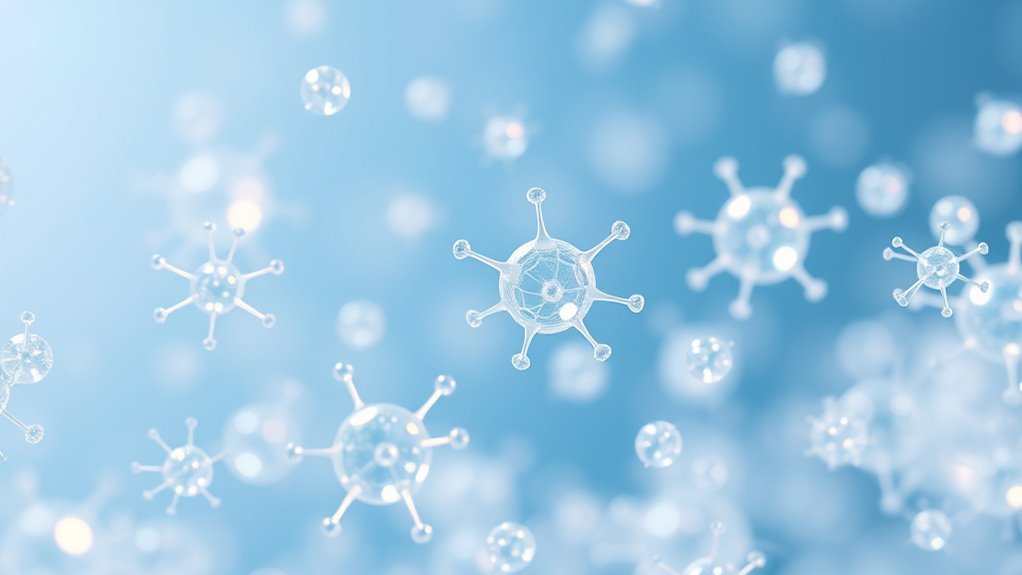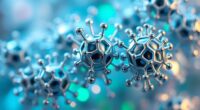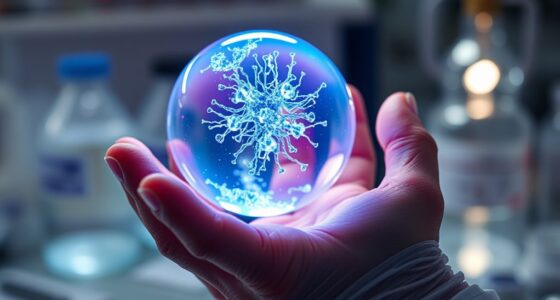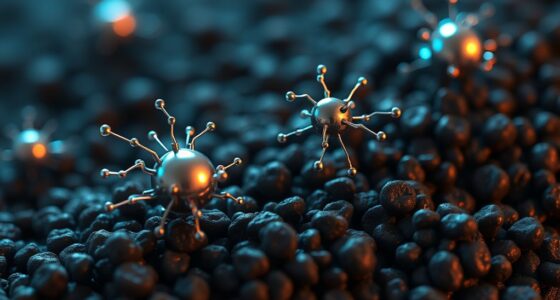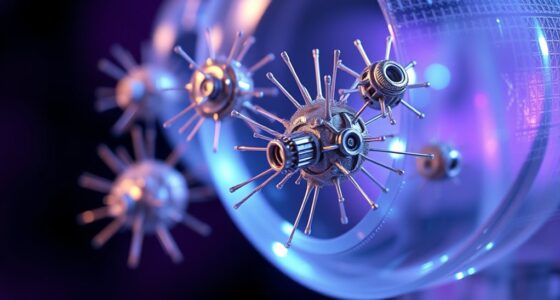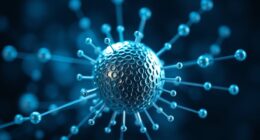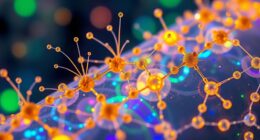To design safe nanomachines, focus on selecting biocompatible materials like lipids, polymers, and inorganic compounds that interact seamlessly with biological systems. Use surface modifications, such as polymer coatings or functional groups, to reduce immune responses and improve stability. Always assess toxicity and biological interactions early on, employing proper evaluations. Emphasizing eco-friendly, sustainable approaches and understanding regulatory standards will help guarantee safety. Keep exploring these strategies to build truly safe, effective nanotechnologies.
Key Takeaways
- Selecting biocompatible materials like lipids, polymers, and inorganic compounds ensures safe integration with biological systems.
- Surface modification techniques, such as polymer coatings and functional groups, optimize nanomachine compatibility and reduce immune responses.
- Conducting thorough toxicity assessments through in vitro and in vivo studies identifies potential risks and guides safe design.
- Employing green synthesis methods and biodegradable materials promotes environmental sustainability and reduces ecological impact.
- Adhering to regulatory standards and collaborative safety assessments ensures nanomachine designs meet safety and biocompatibility requirements.
Understanding Biocompatibility in Nanomaterials
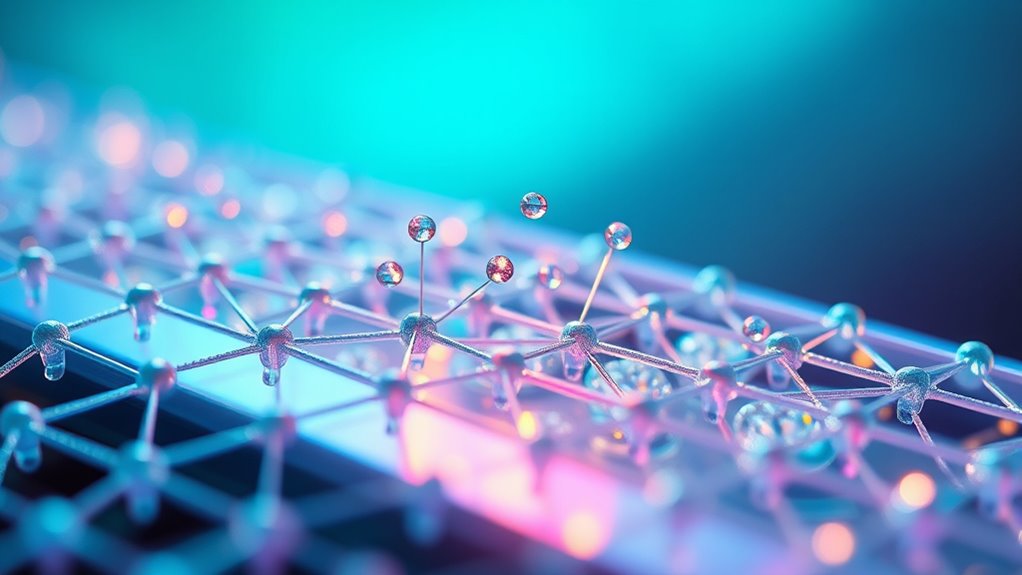
Understanding biocompatibility in nanomaterials is essential because it determines how safely these materials interact with biological systems. When designing nanomachines, you need to confirm that the materials won’t cause toxicity, inflammation, or immune responses. You’ll want to investigate how nanomaterials behave inside the body, including their stability, degradation, and potential to accumulate in tissues. Biocompatibility isn’t just about avoiding harm; it also involves assuring that the materials can perform their intended functions without adverse effects. You should evaluate factors like surface chemistry, size, shape, and charge, which influence how cells and tissues respond. By thoroughly understanding these interactions, you can develop nanomaterials that are both effective and safe for medical applications. Additionally, considering the biocompatibility testing procedures helps ensure that nanomaterials meet safety standards before clinical use.
Key Materials Used in Safe Nanomachine Development
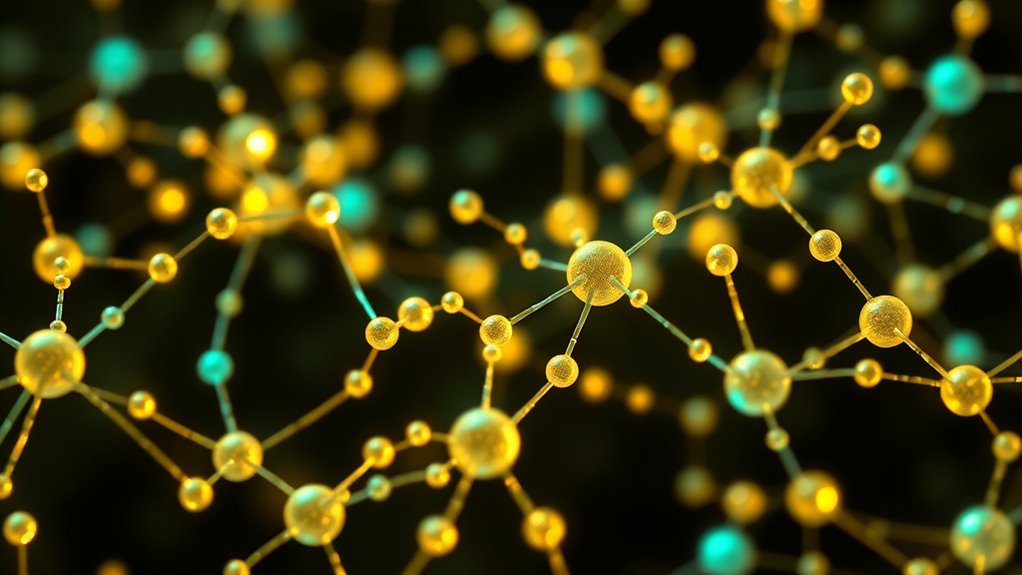
Selecting the right materials is essential for developing safe and effective nanomachines, as these materials must interact harmoniously with biological systems. Biocompatible materials minimize toxicity and immune responses, ensuring safe operation inside the body. Common choices include lipids, polymers, and inorganic compounds like silica and gold. Lipids mimic cell membranes, promoting seamless integration. Polymers such as PEG improve stability and reduce immune detection. Inorganic materials like silica offer durability and functionalization options. Here’s a quick overview: Material Compatibility
Strategies for Surface Modification to Enhance Compatibility
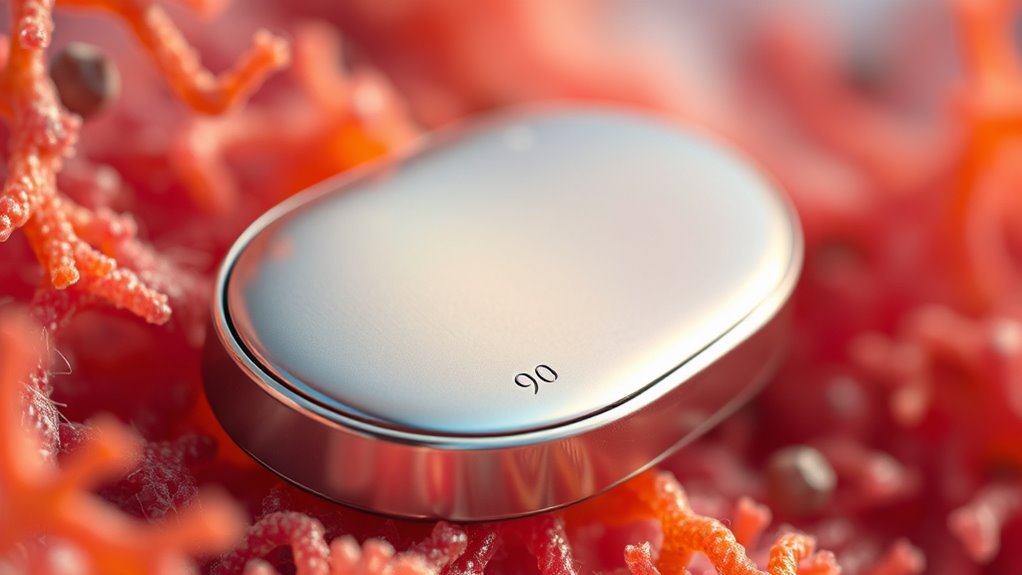
To improve biocompatibility, you can coat nanomaterials with biocompatible polymers that reduce immune responses. Optimizing surface charge helps minimize toxicity and enhances cellular interactions. Additionally, modifying surface functional groups allows you to target specific tissues or cells more effectively. Incorporating vertical storage solutions in the design process can also facilitate better organization and handling of nanomaterials during synthesis and application.
Coating With Biocompatible Polymers
Coating nanomaterials with biocompatible polymers is a crucial strategy to improve their interaction with biological systems. By applying polymers like PEG, PVA, or polysaccharides, you can create a protective layer that minimizes immune recognition and reduces toxicity. This surface modification enhances circulation time, allowing nanomaterials to reach their target sites more effectively. You also benefit from increased stability in physiological environments and decreased aggregation. When selecting a polymer, consider its biocompatibility, solubility, and ability to form a uniform coating. You can apply these coatings through methods like adsorption, covalent attachment, or layer-by-layer assembly. This approach not only improves compatibility but also offers opportunities for further functionalization, such as attaching targeting ligands or therapeutic agents. Additionally, understanding the environmental considerations of nanoparticle use can guide the development of safer and more sustainable nanomachines.
Surface Charge Optimization
Adjusting the surface charge of nanomaterials plays an essential role in improving their biocompatibility and interaction with biological environments. By fine-tuning surface charge, you can minimize unwanted immune responses and promote better cellular uptake. Neutral or slightly negative charges often reduce protein adsorption and decrease toxicity, making nanoparticles safer for use in vivo. You might achieve this by using surface coatings or functional groups that modulate charge without adding bulky materials. Keep in mind, highly charged particles tend to attract plasma proteins, which can lead to rapid clearance or immune activation. Thus, carefully balancing surface charge ensures your nanomaterials remain stable, less immunogenic, and better suited for targeted delivery or diagnostic applications. Proper charge optimization ultimately enhances safety and functionality in biomedical settings. Additionally, understanding AI security vulnerabilities can help develop safer nanomaterials by identifying potential risks associated with their interaction with biological systems.
Functional Group Modification
Functional group modification offers a versatile strategy to enhance nanomaterial compatibility with biological systems. By attaching specific functional groups to the nanomaterial surface, you can improve biocompatibility, stability, and targeting ability. For example, adding hydroxyl or carboxyl groups can increase hydrophilicity, reducing aggregation and immune response. You might also incorporate amino groups to facilitate conjugation with drugs or biomolecules. This surface tailoring allows you to minimize toxicity and promote specific interactions with cells or tissues. Additionally, functional groups can be chosen to avoid unwanted protein adsorption or immune activation. Carefully selecting and modifying surface groups lets you design nanomaterials that integrate seamlessly into biological environments, improving safety and functionality for medical applications. Inspirational quotes can serve as a reminder to stay motivated and focused on your goals while designing these advanced materials.
Assessing Toxicity and Biological Interactions

To guarantee nanomaterials are safe for biological use, you need to understand toxicity evaluation methods and biological compatibility factors. These assessments help identify potential risks and interactions within living systems. By analyzing these points, you can better design nanomaterials that are both effective and safe. Additionally, considering biocompatibility factors such as immune response and cellular uptake is essential for ensuring safe integration into biological environments.
Toxicity Evaluation Methods
Evaluating the toxicity and biological interactions of biocompatible nanomaterials is essential to guarantee their safe application in medical and environmental contexts. You need reliable evaluation methods to identify potential risks before deployment. These methods include in vitro tests, which give quick insights into cellular responses, and in vivo studies that reveal complex biological effects. You should also consider advanced imaging techniques to track nanomaterial behavior inside bodies, and biochemical assays to detect subtle toxicity signals. Incorporating comprehensive assessment practices ensures a thorough understanding of nanomaterials’ safety profiles.
- Feel the urgency of preventing harm to vulnerable patients and ecosystems.
- Recognize the importance of early detection to avoid long-term consequences.
- Appreciate how thorough testing builds trust in nanomaterial safety.
- Understand that rigorous evaluation saves lives and preserves nature.
Biological Compatibility Factors
Understanding the biological compatibility of nanomaterials is crucial because their interactions with living systems determine safety and effectiveness. You need to evaluate how these materials interact with cells, tissues, and fluids, considering factors like surface chemistry, size, and shape. Assessing toxicity involves examining cellular uptake, potential inflammation, and long-term accumulation. You should also consider immune responses, ensuring the nanomaterials don’t trigger adverse reactions. Surface modifications, such as coating with biocompatible agents, can improve compatibility and reduce toxicity. Additionally, understanding biodistribution and clearance helps predict how nanomaterials behave inside the body. By thoroughly analyzing these biological factors, you can design nanomaterials that are safer, more effective, and truly compatible with biological environments.
Innovations in Eco-Friendly and Sustainable Nanomaterials

Recent advances in eco-friendly and sustainable nanomaterials are transforming how you address environmental challenges. These innovations focus on reducing ecological impact while maintaining performance. You can now explore biodegradable nanomaterials derived from natural sources, minimizing waste and pollution. Green synthesis methods use plant extracts and renewable resources, lowering toxic chemical use. Such technologies inspire hope for a cleaner future by promoting responsible manufacturing. You’ll find new materials that are safe for ecosystems, supporting biodiversity and reducing hazards. These developments empower you to create solutions that align with sustainability goals. Biodegradable nanomaterials are gaining attention for their potential to further minimize environmental footprints.
Challenges in Achieving Targeted Delivery Without Off-Target Effects

Achieving targeted delivery with nanomaterials remains a significant challenge because ensuring precision without affecting healthy tissues requires overcoming complex biological barriers. Your nanomachines must navigate obstacles like the immune system, cellular membranes, and varying tissue environments. Ensuring they reach the intended site without off-target effects demands precise control over size, surface chemistry, and functionalization. However, nanoparticles can sometimes bind unintentionally to non-target cells or be cleared prematurely, reducing effectiveness and risking side effects. Balancing stability in circulation with the ability to release payloads at the target site is tricky. You need to design nanomaterials that can distinguish between healthy and diseased tissues, which remains a major hurdle in developing safe, effective targeted therapies. Relationships – Personality Test
Regulatory Frameworks and Safety Standards for Nanomaterials
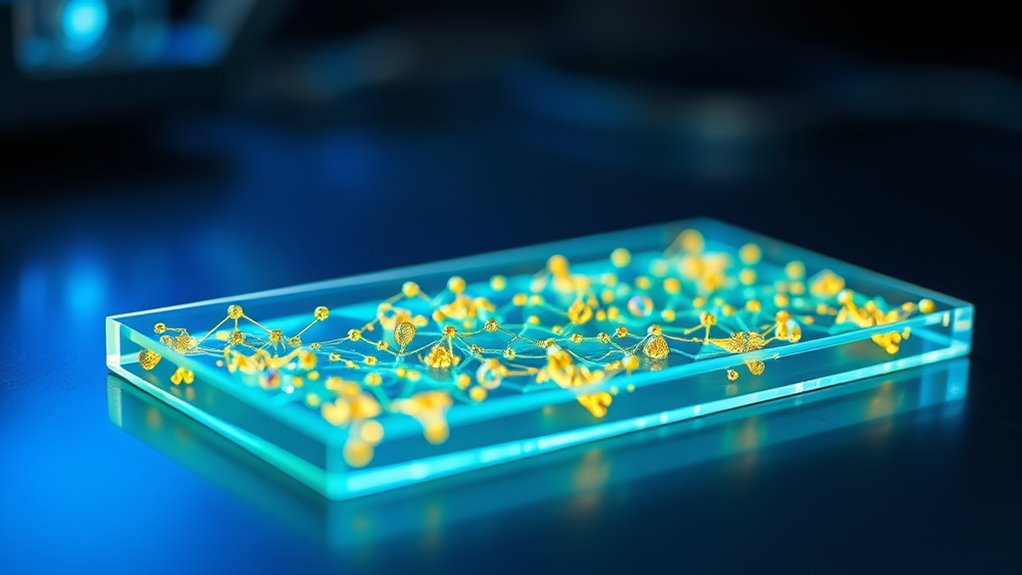
You need to understand how international regulatory agencies develop safety assessment protocols for nanomaterials. These standards guide the evaluation of risks and guarantee biocompatibility across different regions. Staying informed about these frameworks helps you navigate compliance and promote safe nanomaterial applications.
International Regulatory Agencies
How do international regulatory agencies guarantee the safe development of nanomaterials? They establish unified standards and monitor compliance across borders, ensuring consistent safety practices worldwide. These agencies foster collaboration among scientists, industry leaders, and policymakers, creating a global framework that prioritizes public health. They also promote transparency, making safety data accessible and understandable.
You can feel reassured knowing that:
- Risk assessments are standardized to prevent unforeseen hazards
- Global safety benchmarks protect communities everywhere
- Continuous oversight minimizes potential misuse or accidents
- International cooperation accelerates safe innovation
Safety Assessment Protocols
Safety assessment protocols for nanomaterials are essential components of regulatory frameworks that guarantee their safe development and use. You need to follow standardized procedures to evaluate potential risks, including toxicity, environmental impact, and biocompatibility. These protocols involve thorough testing, such as in vitro and in vivo studies, to identify any adverse effects. You should also consider exposure levels, particle size, and surface properties, which influence safety profiles. Regulatory agencies require detailed documentation and risk assessments before approval. Implementing consistent safety standards helps prevent harmful consequences and ensures public trust. As a developer or researcher, you must stay informed about evolving guidelines and adopt best practices for safety evaluation, making sure nanomaterials are both effective and safe for their intended applications.
Case Studies of Successful Biocompatible Nanomachines

Successful development of biocompatible nanomachines has demonstrated their potential to revolutionize medicine and biotechnology. You’ve seen how these tiny devices can target cancer cells with precision, deliver drugs directly where needed, and even repair damaged tissues. These breakthroughs show that safe, effective nanomachines are no longer just theoretical—they’re transforming healthcare. Imagine the impact of:
- Restoring mobility through targeted tissue regeneration
- Eliminating stubborn infections with precision nanobots
- Monitoring health in real-time via implantable sensors
- Reducing side effects by delivering drugs exactly where they’re needed
These case studies prove that thoughtful design and biocompatibility can lead to life-changing innovations, inspiring confidence in the future of safe nanotechnology. You’re witnessing the dawn of a new era in medical science.
Future Directions in the Design of Safe Nanotechnologies

Building on recent advances in biocompatible nanomachines, researchers are now focusing on innovative strategies to enhance their safety and effectiveness. Future directions include developing smarter materials that respond to environmental cues, reducing toxicity, and improving targeted delivery. You’ll see more emphasis on designing biodegradable nanomaterials that naturally break down after use, minimizing accumulation in the body. Additionally, integrating real-time monitoring capabilities will allow you to track nanomachine performance and safety. The table below highlights key areas shaping this future:
| Focus Area | Goal |
|---|---|
| Biodegradable Materials | Minimize long-term accumulation |
| Environmental Responsiveness | Improve control and adaptability |
| Real-Time Monitoring | Ensure safety and functionality in vivo |
Interdisciplinary Approaches to Advancing Biocompatible Nanomaterials

Advancing biocompatible nanomaterials requires a collaborative effort across multiple disciplines, blending expertise from chemistry, biology, engineering, and materials science. Your role is essential in integrating these fields to create safer, more effective nanomachines. When you combine insights from biology, you ensure compatibility with living systems. Engineering principles help optimize functionality and stability. Chemistry guides the design of non-toxic, biodegradable materials. Materials science enables the development of innovative structures that mimic nature’s complexity. This interdisciplinary synergy fuels innovation, sparks new ideas, and accelerates breakthroughs. You can:
- Harness diverse perspectives to solve complex challenges
- Drive the creation of smarter, safer nanomaterials
- Foster collaborations that inspire novel solutions
- Make a lasting impact on healthcare and environmental safety
Frequently Asked Questions
How Do Biocompatible Nanomaterials Degrade Inside the Body?
Biocompatible nanomaterials degrade inside your body through natural processes like hydrolysis, enzymatic reactions, or oxidation. These materials are designed to break down into harmless byproducts that your body can readily eliminate. Enzymes target specific bonds within the nanomaterials, gradually disassembling them without causing inflammation or toxicity. This controlled degradation ensures your body safely clears the nanomaterials after they’ve performed their function, minimizing potential side effects.
What Are the Environmental Impacts of Nanomaterial Disposal?
You should consider that nanomaterials can pose environmental risks when disposed of improperly. They might accumulate in ecosystems, harming aquatic life and soil health, or cause toxicity to plants and animals. Proper disposal methods, such as recycling or containment, are essential to minimize these impacts. Stay informed about regulations and best practices to reduce potential environmental hazards and promote sustainable use of nanomaterials.
How Can Nanomaterials Be Customized for Personalized Medicine?
Imagine customizing nanoparticles to deliver chemotherapy directly to a tumor, reducing side effects. You can modify nanomaterials’ surface properties, size, and drug load to target specific cells, ensuring precision. By attaching ligands that recognize cancer markers, you personalize treatments. This approach enhances effectiveness and minimizes harm, making therapies safer and more tailored. You can also monitor treatment progress with embedded imaging agents, ensuring ideal outcomes for each patient.
What Are the Long-Term Effects of Nanomachine Exposure?
You might worry about long-term effects, but current research suggests that with proper design, nanomachines can mitigate risks like tissue buildup or unforeseen immune responses. Continuous studies are essential to monitor potential toxicity or environmental impact over time. By staying informed and advocating for rigorous testing, you help ensure that nanomachines remain safe for long-term use, reducing health concerns and promoting responsible development in nanotechnology.
How Do Different Biological Environments Influence Nanomaterial Stability?
Think of biological environments as a bustling marketplace, full of surprises that can either shield or corrode your nanomaterials. The pH level, enzymes, and ionic strength directly influence their stability, acting like guardians or villains. You’ll find that in blood, nanomaterials tend to remain stable, while in acidic lysosomes, they may degrade faster. Adapting your designs to these environments guarantees your nanomachines function safely and effectively.
Conclusion
Just as Icarus’s wings needed to be carefully crafted to avoid disaster, designing biocompatible nanomaterials demands meticulous attention to safety and sustainability. By understanding materials, optimizing surface modifications, and adhering to standards, you can create nanomachines that work harmoniously within biological systems. Embrace innovation responsibly, like Prometheus bringing fire—powerful yet requiring careful control—to guarantee your advancements benefit, not harm, the world around you.
